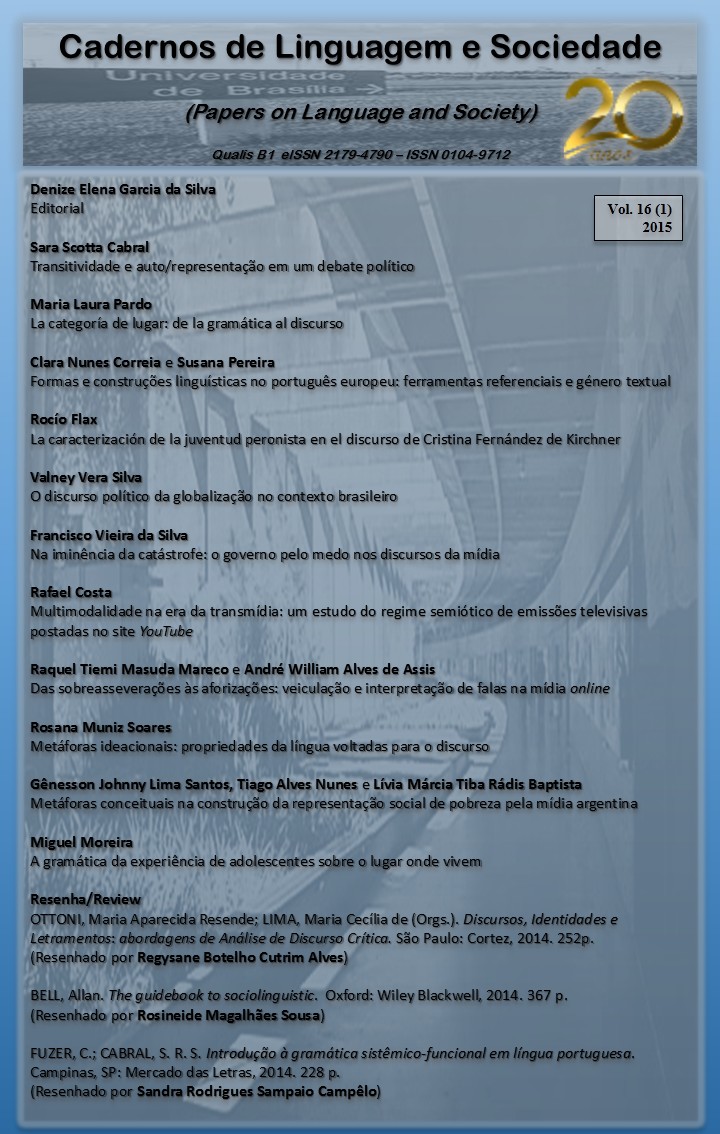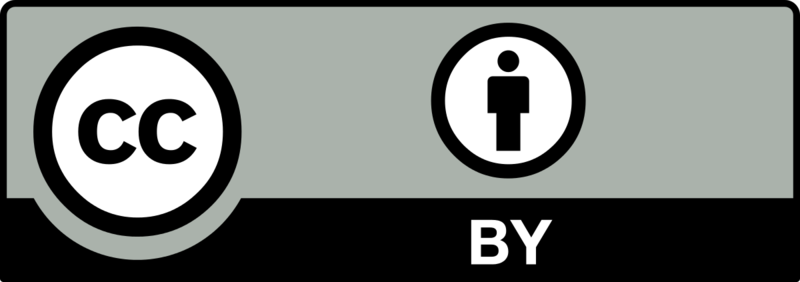Multimodality in transmedia age: a study of the semiotic setting from TV shows posted on YouTube
DOI:
https://doi.org/10.26512/les.v16i1.7535Keywords:
transmedia; multimodality, language metafunctionAbstract
Language practices in media environments take place increasingly under the impact of transmedia (JENKINS, 2008), or trans-media content delivery. Such migration happens incessantly in media such as the television and the Internet. Hence, we wonder how the construction of meaning in audiovisual genres is realized in different media. The intention is to draw a parallel between language resources and multimodal discourses. We take hold of Kress' (2010) assumptions to identify the role of semiosis in a corpus from three videos in the YouTube site. The analysis is based on the metafunction category (Kress, van Leeuwen, 2006). We note that the change of medium causes a reordering of these macrofunctions.
Downloads
References
CHIEW. A. K. K. Multisemiotic mediation in hypertext. In: O'HALLORAN, K. (Ed.) Multimodal discourse analysis: Systemic-Functional Perspectives. London; New York: Continuum, 2004.
COSTA, R. R. Broadcast yourself: o avanço do vídeo digital e o empoderamento da audiência. In: VII Encontro Nacional de História da Mídia, 2009, Fortaleza. Anais do VII Encontro Nacional de História da Mídia. São Paulo: Rede Alcar, 2009.
____. A TV na web: percursos da reelaboração de gêneros audiovisuais na era da transmídia. Dissertação (Mestrado em Linguística) ”“ Programa de Pós-Graduação em Linguística. Universidade Federal do Ceará, Fortaleza, 2010.
DAWKINS, R. O gene egoísta. São Paulo: Companhia das Letras, 2007.
DIONISIO, A. P. . Intertextualidade e multimodalidade na escrita didática. In: MOURA, V.; DAMIANOVIC, M. C.; LEAL, V. (org.). O ensino de línguas: concepção & práticas universitárias. 1 ed. Recife: Editora da UFPE, 2010, v. 1, p. 163-175.
DONDIS, D. A. A primer of visual literacy. Cambridge: MIT Press: 1974.
FELTRIN, R. Record cresce 117% em seis anos; Globo e SBT despencam. UOL Notícias - Ooops! São Paulo, 06 out. 2010. Disponível em: http://noticias.uol.com.br/ooops/ultimasnoticias/2010/10/06/record-cresce-117-em-seis-anos-globo-e-sbt-despencam.jhtm. Acesso em 08 set. 2013.
FORD, A. Navegações: comunicação, cultura e crise. Rio de Janeiro: Editora da UFRJ, 1999.
GOMES, L. F. Hipertextos multimodais: o percurso de apropriação de uma modalidade com fins pedagógicos. Tese de Doutorado. Campinas: Doutorado em Linguística Aplicada da Universidade de Campinas, 2007.
HALLIDAY, M. A. K. An introduction to Functional Grammar. 3. ed., Oxford, Londres: Arnold, 1994.
HALLIDAY, M. A. K.; MATHIESEN, C. M. I. M. (revised by). An introduction to Functional Grammar. 3. ed., Londres: Hodder Education, 2004.
HARLEY, D.; FITZPATRICK, G. YouTube and intergenerational communication: The case of Geriatric1927. Universal access in the information society, Heidelberg, n. 8, p. 5-20, 2009.
HODGE, R.; KRESS, G. Social semiotics. Ithaca: Cornell University Press, 1988.
JENKINS, H. Cultura da convergência. São Paulo: Editora Aleph, 2008.
JOST, F. Seis lições sobre televisão. Porto Alegre: Sulina, 2004.
KRESS, G. Multimodality: a social semiotic approach to contemporary communication. Nova Iorque: Routledge, 2010.
KRESS, G.; VAN LEEUWEN, T. Multimodal discourse: the modes and media of contemporary communication. Londres: Hodder Arnold, 2001.
____. Reading images: the grammar of visual design. Londres: Routledge, [1996] 2006.
LEMKE, J. L. Travels in hypermodality. London, Thousand Oaks, CA, New Delhi: SAGE Publications, Vol. 1, 2002, p. 299-325.
MAZETTI, H. M. Cultura Participativa, espetáculo interativo: do “empoderamento” ao engajamento corporativo dos usuários de mídia. In: XIV Congresso de Ciências da Comunicação na Região Sudeste, 2009, Rio de Janeiro. Anais do XIV Congresso de Ciências da Comunicação na Região Sudeste, 2009.
NIELSEN, J. Scrolling and Attention. In: Jakob Nielsen’s Alertbox. Disponível em: <http://www.useit.com/alertbox/scrolling-attention.html>. Acesso em: 25 mar. 2010.
O'HALLORAN, K. (ed.) Multimodal Discourse Analysis: Systemic-Functional Perspectives. London; New York: Continuum, 2004.
O'REILLY, T. What is Web 2.0. In: O'REILLY, 2005. Disponível em: <http://oreilly.com/web2/archive/what-is-web-20.html>. Acesso em 08 set. 2013.
PRIMO, A. A interação mediada por computador: a comunicação e a educação a distância segundo uma perspectiva sistêmico-relacional. Tese (Doutorado em Informática na Educação) ”“ Programa de Pós-Graduação em Informática na Educação. Universidade Federal do Rio Grande do Sul, Porto Alegre, 2003.
RECUERO, R. C. Memes e dinâmicas sociais em weblogs: informação, capital social e interação em redes sociais na Internet. InTexto, v. 15, p. 1, 2006.
_____. Redes sociais na internet. Porto Alegre: Sulina, 2009.
YOUTUBE. Histórico da empresa. Disponível em: <http://www.youtube.com/yt/about/>. Acesso em 08 set. 2013.



